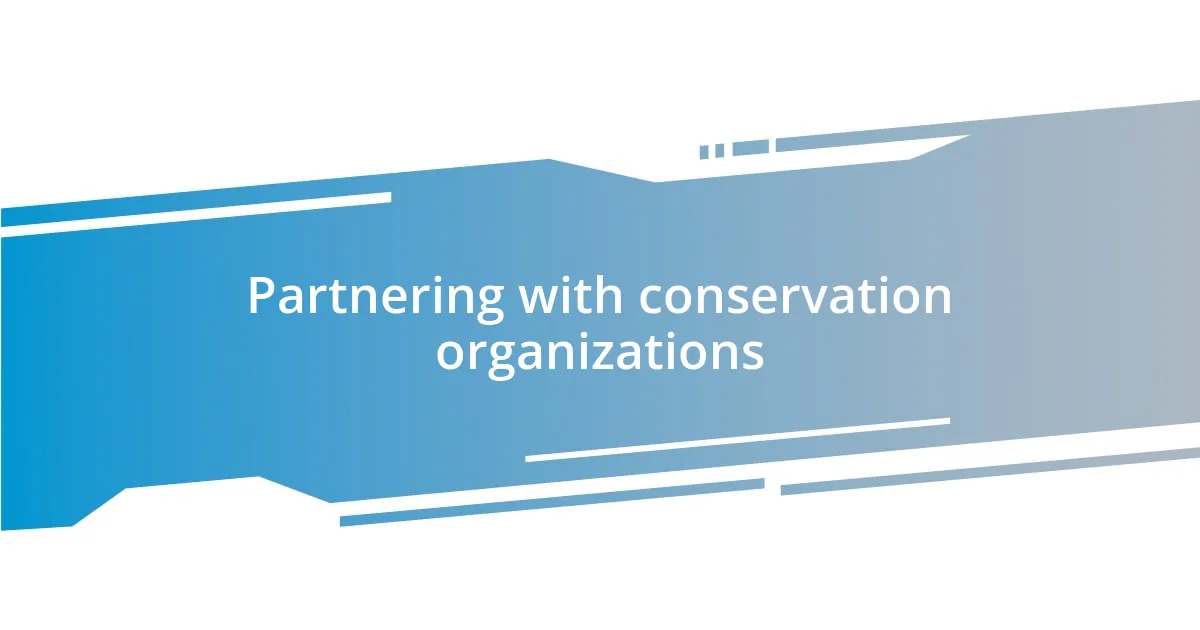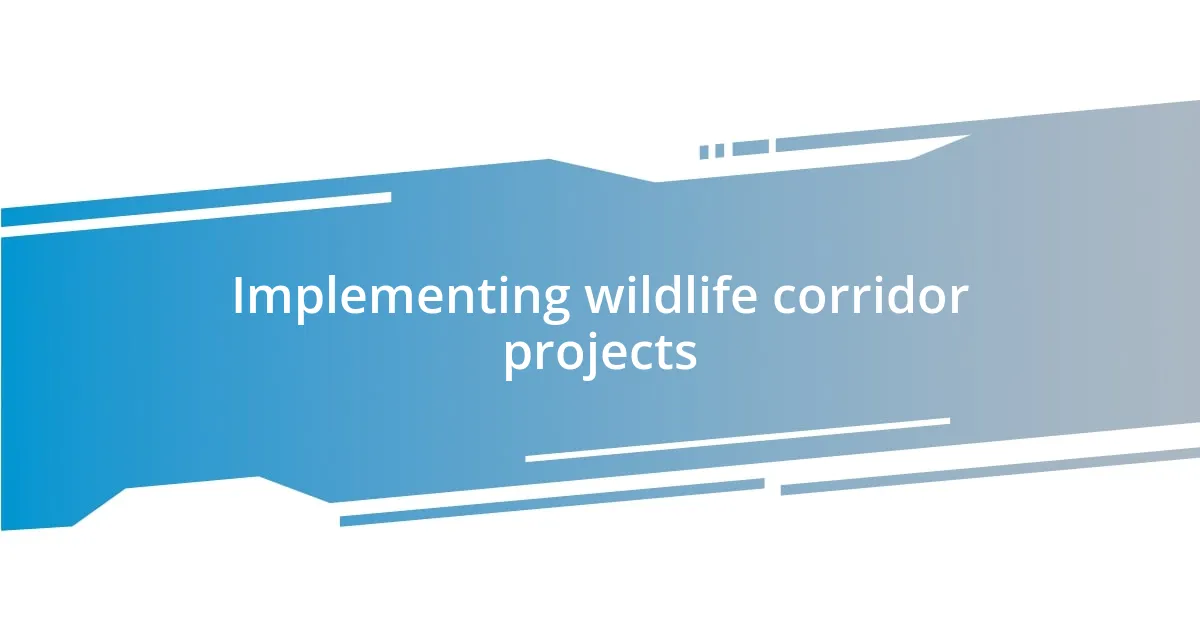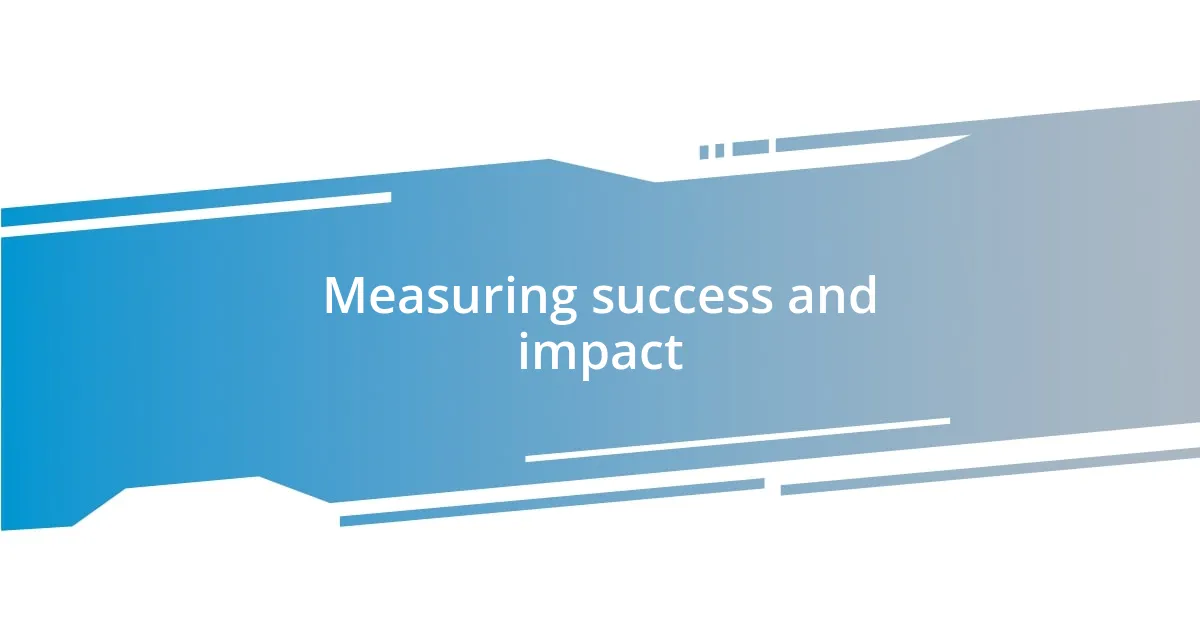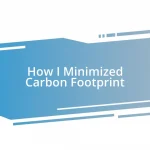Key takeaways:
- Wildlife corridors are essential for biodiversity, enabling safe animal migration and habitat connectivity.
- Understanding local wildlife needs, including food, shelter, and safe passage, is crucial for effective corridor design.
- Community engagement through workshops and storytelling fosters collaboration and shared responsibility for conservation efforts.
- Measuring success involves observing wildlife interactions and assessing community involvement in restoration projects.

Understanding wildlife corridors importance
Wildlife corridors play a crucial role in preserving biodiversity. I’ve always felt a deep connection to nature, and seeing firsthand how these corridors allow animals to safely migrate and find mates reinforced my belief in their importance. Have you ever witnessed the thrill of spotting a deer or a family of rabbits in your neighborhood? That excitement hinges on ensuring their habitats remain intact and connected.
The fragmentation of habitats due to urban development poses a significant threat to wildlife populations. I remember volunteering with a local group where we studied a stretch of land that had been divided by roads. The frustration in watching wildlife struggle to cross such barriers left a lasting impression on me. It made me realize how critical it is to create pathways that facilitate safe passage, allowing species to thrive rather than mere survival.
Imagine a future where landscapes are scarred, and the symphony of nature is silenced because animals can no longer travel to find food or mates. That thought haunts me. The beauty of our ecosystems relies on interconnectivity, and wildlife corridors serve as lifelines. They not only sustain wildlife but enrich our own experiences with the natural world, reminding us of the delicate balance we must protect.

Identifying local wildlife needs
Identifying the needs of local wildlife is essential for establishing effective corridors. During my observations in nearby parks, I noticed how certain species preferred specific routes for their daily journeys. It struck me that understanding what wildlife requires—like food sources, safe passageways, and resting spots—can drastically impact their ability to flourish. I often find myself thinking about how small changes in our environment can shape the lives of these creatures.
To better inform our conservation efforts, I found it useful to focus on these key wildlife needs:
- Food Accessibility: Identifying native plants and food sources essential for local species.
- Safe Passage: Recognizing existing barriers, like roads and fences, that inhibit movement.
- Shelter: Mapping natural shelters, such as dense thickets or old tree cavities, where animals can rest or raise young.
- Water Sources: Ensuring there are clean and abundant water sources available for wildlife.
These observations and insights remind me of the intricate web of life in our backyards and how crucial it is to advocate for these needs. Each discovery deepens my commitment to developing wildlife corridors that cater to the unique demands of our local inhabitants.

How to assess corridor locations
Assessing potential wildlife corridor locations hinges on a mix of field observation and community input. In my experience, mapping out existing wildlife trails provides invaluable insight. I remember following a narrow deer path through the woods, realizing it wasn’t just a route to food; it was the lifeline connecting different habitats. When I observed how the deer avoided busy roads and instead navigated through dense brush, it made me appreciate the importance of maintaining these pathways.
Another key aspect is understanding the landscape itself. Through my explorations, I’ve learned to look at elevation changes, vegetation types, and even human developments that can influence animal movements. When I volunteered for a corridor assessment project, I found that installing trail cameras offered an eye-opening perspective. I was excited every time I reviewed the footage and saw species using the corridors—my heart raced at the thought of how these simple paths could drastically impact their survival.
Lastly, engaging with the local community can greatly enhance corridor assessments. Conversations with fellow nature enthusiasts and conservationists often reveal surprising insights. I recall a chat with a neighbor who spotted a family of foxes regularly crossing her backyard. This anecdote not only highlighted a potential corridor but also sparked a community initiative to protect that area. Gathering such local knowledge creates a more comprehensive understanding of where and how corridors should be established.
| Assessment Method | Description |
|---|---|
| Field Observation | Track and map existing wildlife paths to identify natural movement routes. |
| Landscape Analysis | Consider geographical features and vegetation types that facilitate or hinder wildlife movement. |
| Community Input | Engage locals to gather stories and sightings that can inform corridor planning. |

Engaging with community stakeholders
Engaging with community stakeholders is pivotal in the quest for establishing wildlife corridors. I recall one evening at a community meeting where people shared their own wildlife experiences. Listening to a retired schoolteacher recount how she spotted owls nesting in her backyard sparked a collective moment of realization. It made me wonder—how many of us have untapped stories like these that can guide our conservation efforts?
One impactful strategy I employed involves organizing local workshops where residents could voice their concerns and ideas. At one such workshop, a farmer spoke about how migrating deer often damaged his crops. Instead of viewing this as a nuisance, we brainstormed ways to create safe passages that benefit both the wildlife and the agricultural community. Isn’t it fascinating how a shared goal can transform challenges into collaborative solutions?
Building relationships with stakeholders isn’t just about gathering information; it’s also about fostering a shared sense of responsibility. I remember a father and son who attended a cleanup event I organized. They discovered an old stream where their family often fished, now clogged with debris. Their enthusiasm transformed into activism as they pledged to help restore that area for both their enjoyment and the wildlife it supports. Conversations like these conjure hope, reminding me that when community voices unite, we can truly influence the future of wildlife corridors together.

Partnering with conservation organizations
Partnering with conservation organizations has been one of the most rewarding experiences in my efforts to enhance local wildlife corridors. I distinctly recall a meeting with a local conservation group where we discussed aligning our initiatives with theirs. It was empowering to hear how they had successfully implemented corridor projects in other regions. Their insights made me realize that collaboration amplifies our individual efforts; we’re all striving for the same goal – the protection of biodiversity.
I vividly remember one project where we joined forces to restore a vital greenway that connected two fragmented habitats. During this collaboration, I had the chance to participate in a tree-planting event. I saw the joy on volunteers’ faces as they dug holes and placed saplings into the earth. Every new tree symbolized a step forward in reestablishing a habitat for countless species. It made me reflect on the interconnectedness of our actions; each partnership not only strengthens wildlife corridors but also builds community spirit.
Moreover, I’ve found that sharing our successes and challenges with conservation organizations often leads to insightful strategies that would be hard to develop alone. At one joint workshop, we discussed the impact of urban development on animal movements. I shared a personal experience about spotting wildlife struggling to cross roads, and as it resonated with others, we brainstormed creative solutions like wildlife crossing signs and fencing. Isn’t it incredible how diverse perspectives can illuminate new paths forward? Together, we are like puzzle pieces, joining forces to create a bigger picture for wildlife conservation.

Implementing wildlife corridor projects
One of the most transformative moments in implementing wildlife corridor projects came during a walk along a potential trail site. As I stood there, I noticed a family of rabbits darting across the area. Their natural behavior struck me; they were embracing their habitat, navigating it with a sense of instinct. I realized that creating corridors isn’t just about physical paths—it’s about respecting and understanding these creatures and their needs. How do we ensure that our initiatives truly serve wildlife? By observing and listening, we can develop effective projects that resonate with nature’s rhythms.
During our initial phases, we encountered significant skepticism from some community members. I remember one particularly passionate resident who argued that building corridors could hinder local development. Instead of brushing off his concerns, I invited him to join a site visit. Walking together through the landscapes we envisioned transforming, I saw his perspective shift. He began to understand that wildlife corridors could coexist with community needs, ultimately enhancing our local environment. This experience made me reflect on the power of shared experiences; they can dismantle barriers and foster understanding between opposing views.
As we moved forward with the project, I took the opportunity to document our progress and challenges through a community blog. The first time I shared a before-and-after photo of a restored habitat, the responses were incredible. People began to voice their excitement and share their own sightings of returning wildlife, like foxes and migratory birds. Isn’t it amazing how a simple photo can create a sense of ownership in a project? I’ve learned that involving the community in storytelling not only celebrates our achievements but also reinforces collective responsibility for wildlife conservation efforts.

Measuring success and impact
Measuring success in wildlife corridors isn’t merely about the number of trees planted or miles restored—it’s about observing real-time wildlife interactions. I fondly recall one afternoon when a group of us set up wildlife cameras along a newly established corridor. The thrill of checking those cameras and finding footage of deer comfortably traversing the space was palpable. It made me realize that every animal captured on film represented a victory not just for our group, but for the ecosystem as a whole. Isn’t it astonishing how a few simple images can validate our hard work?
Another key indicator of impact I’ve noticed is community involvement. I vividly remember a local volunteer day when families flocked to plant native shrubs along the corridor. As we worked side by side, I asked those volunteers why they felt drawn to this project. Their responses—ranging from wanting to preserve the land for their children to witnessing a resurgence in bird species—painted a broader picture. By fostering emotional connections to the environment, we weren’t just planting trees; we were cultivating stewards of the land. Isn’t that a powerful reflection of success?
Finally, we’ve learned to assess our projects by monitoring changes in wildlife diversity over time. During one assessment, we recorded an increase in rare species, and I felt a swell of pride wash over me. Each data point wasn’t just a statistic; it felt like a heartfelt thank you from nature. I often wonder: are we fully appreciating our role in these ecosystems? Success, I believe, lies in our ability to connect these numbers with genuine stories of life restored and habitats enhanced, creating a legacy that extends far beyond our immediate efforts.














